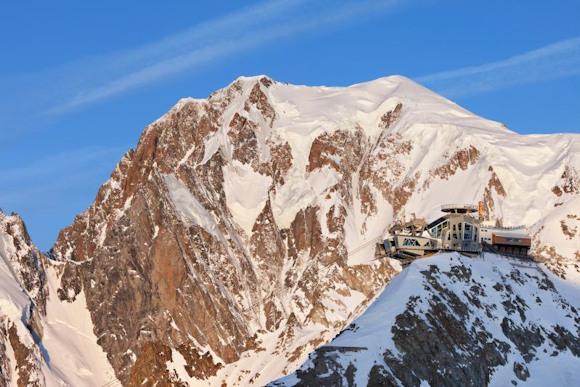The territorial dispute between Italy and France concerning the Mont Blanc Massif area, which has long been at the center of disputes between the two nations, is brought back to the headlines by means of the government's response, on 12 October last, to the question parliamentarian of 5 August 2019 of the group leader in the Chamber of FdI Francesco Lollobrigida (after 14 months).
In his question, Lollobrigida emphasized the fact that the borders between Italy and France, in the Mont Blanc Massif area, have long been the subject of an international dispute concerning the summit of Mont Blanc and the Colle del Gigante area, Punta Helbronner: of importance for Italy as a point of arrival of the cable car from Courmayeur as well as the site of the historic Turin refuge.
The territorial question goes back, therefore, even before the unification of the Kingdom of Italy, in fact this controversy arises from official French cartography in which state borders are drawn in violation of international treaties. In fact, both the Treaty of Turin of March 24, 1860 and the Treaty of Paris of February 10, 1947, establish that the border between Italy and France runs on the watershed, or on the watershed line of the Colle del Gigante, leaving a substantial portion of Punta Helbronner and the whole area surrounding the Torino refuge, in the Italian territory.
The motivation for the territorial acquisition by the French is, of course, economic.
The situation worsened in 2015 - continues Lollobrigida - following the opening to the public of the Italian cableway plant called “Skyway Monte Bianco” which connects Courmayer with Punta Helbronner and the consequent commercial success achieved in competition with the French equivalent of Chamonix.
The first French move, by the mayor of Chamonix, is to arbitrarily install locking systems at the gate that the Italian cableway operator had placed on the terrace of the Torino refuge, for safety reasons, thus preventing direct access. from refuge to the Giant Glacier and the peaks of the Massif.
Also thanks to the question presented at the time of Senator Aldo Di Biagio, an agreement was reached between the two countries, with which it was established that in the future no party would undertake unilateral acts on the portions of the territory concerned.
Let's come to last year: with a joint ordinance, the municipalities of Chamonix and Saint-Gervais, on June 27, 2019, banned paragliding over the whole area surrounding the summit of Mont Blanc, invading, de facto, even the territory under Italian sovereignty.
The Military Geographical Institute, having received the notification of the Ordinance by the GdF of Entrèves (Courmayeur), informed the Foreign Ministry, inviting the Farnesina to take action to find a solution.
The Aosta prosecutor's office opened a file while the mayor of Courmayeur, Stefano Miserocchi, forwarded the documentation to the Valle d'Aosta region, asking to arrange a meeting to discuss the matter.
What initiative will the Italian government intend to take?
-
to protect the national interest and the sovereignty of the Italian state in the Mont Blanc areas described in the introduction;
-
to support the territorial institutions involved in the management of administrative and economic problems relating to tourism, sports and mountaineering activities that take place in those crucial areas for accessing the Massif and the summit of Mont Blanc;
-
to reach the definitive resolution of a diplomatic dispute that has been dragging on for over 70 years, during which, in the opinion of the questioner, Italy has always suffered the unilateral and arbitrary initiatives of the French authorities.
The government's response came on October 12, from Undersecretary for Foreign Affairs Scalfarotto:
The Ministry of Foreign Affairs, through the Embassy in Paris, immediately proceeded to formally and firmly represent to the French authorities the traditional Italian line regarding the border, both as a ration to the violation of borders and national sovereignty, symbolically carried out by the administrative provision of the French local authorities, both with the aim of avoiding that an alleged Italian acquiescence to the French claims may be invoked in the future, such as to prejudice our position.
To us, however, the French action did not seem "symbolic".
The undersecretary went on to highlight the initiatives undertaken.
In addition to representing Italy's disappointment for the border violation, in the verbal note sent to the French authorities we recalled that Italy has on several occasions in the past expressed its willingness to start bilateral consultations with France to examine the discrepancies of the respective cartography on Mont Blanc.
At the same time we have taken steps to renew to the French authorities the opening to dialogue for a desirable joint solution to the issue.
In practice, the French have appropriated about 82 hectares of Italian territory, thanks to a unilateral interpretation by Paris that claims in the name of historical rights acquired thanks to (incorrect) geographical maps of the nineteenth century. Furthermore, at the basis of the Italian right of possession, there is the constant practice on the ground which indicates an exercise, without solution of continuity, of the areas that the transalpines would like to remove from us.
Perhaps a government action, while waiting for the French to respond to our requests, could be to have an Alpine department carry out an exercise in the disputed territory. Just to show, once in a while, that we are not always willing to turn the other cheek.
Photo: Funivie Monte Bianco SpA












